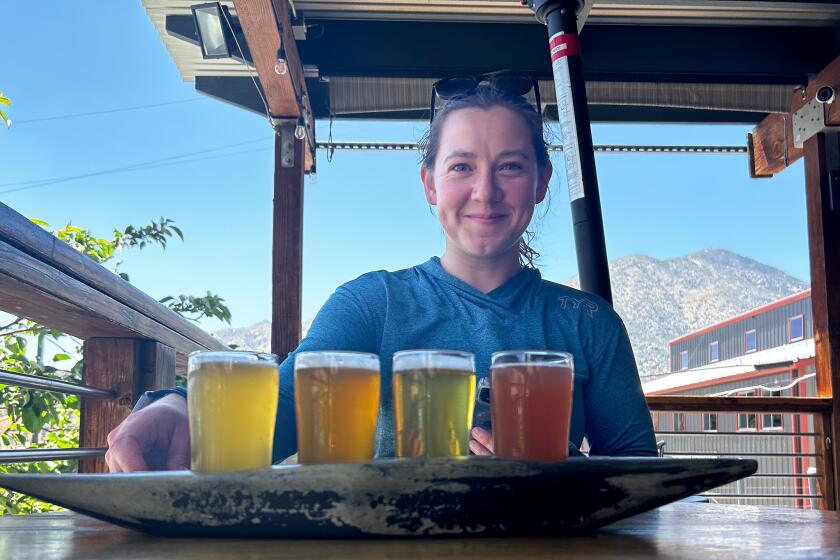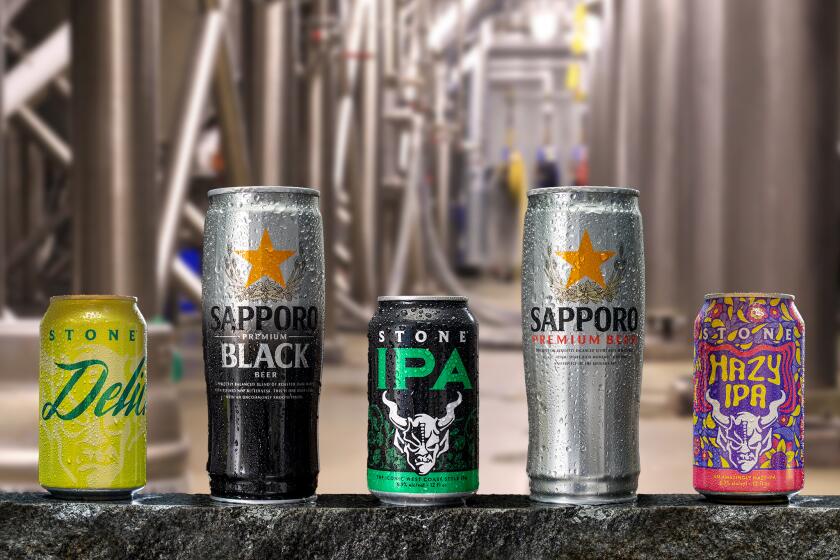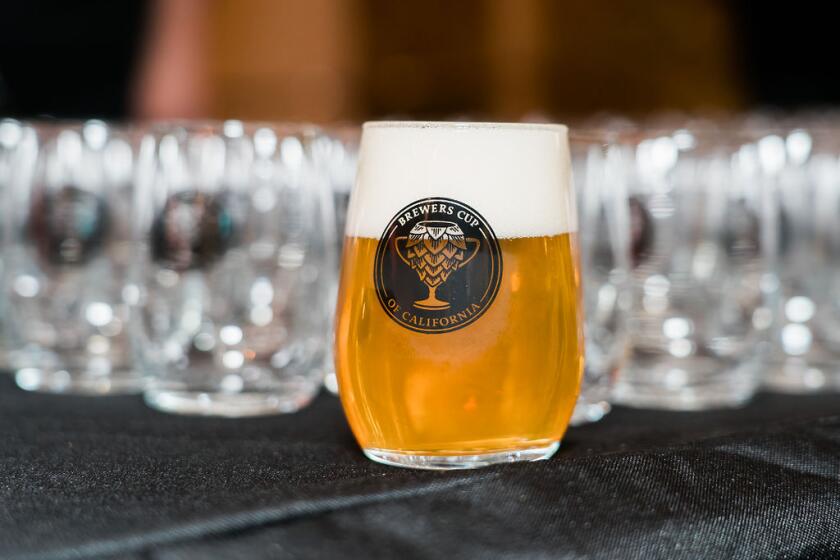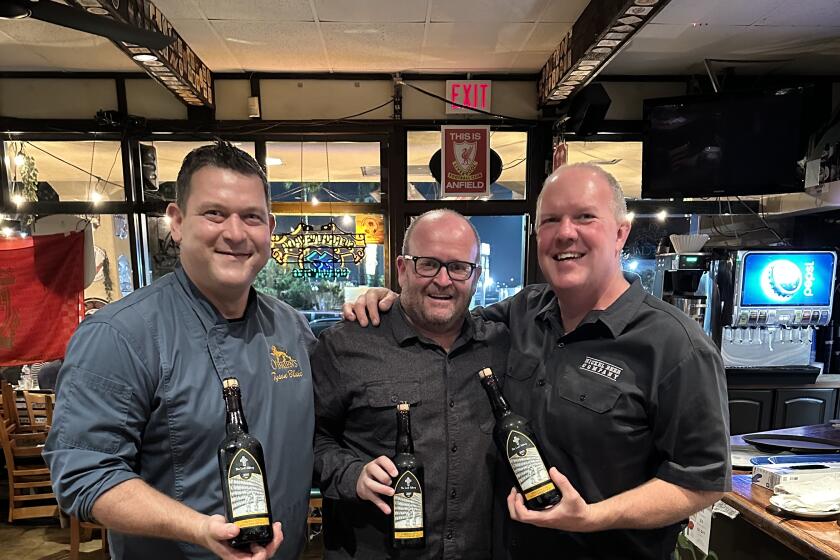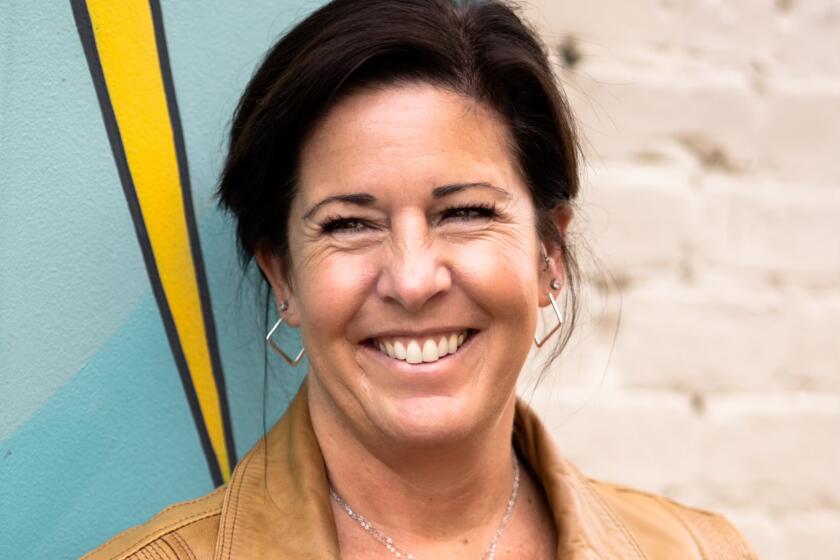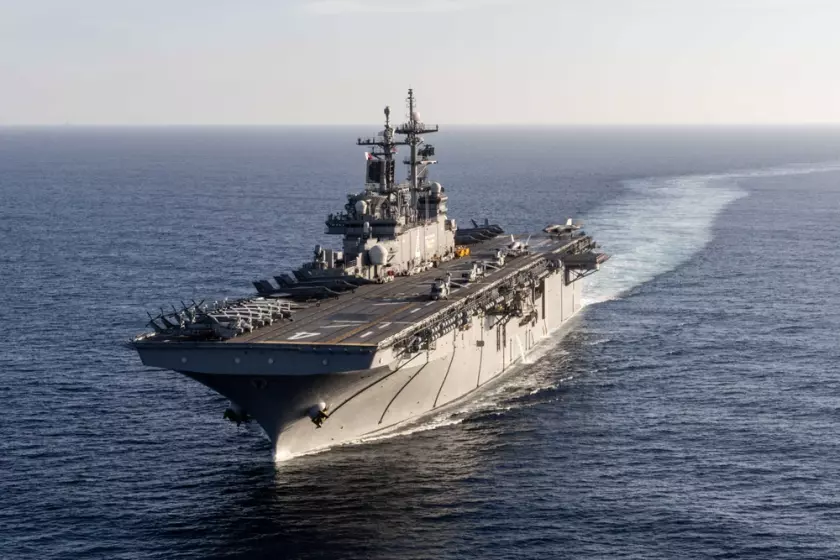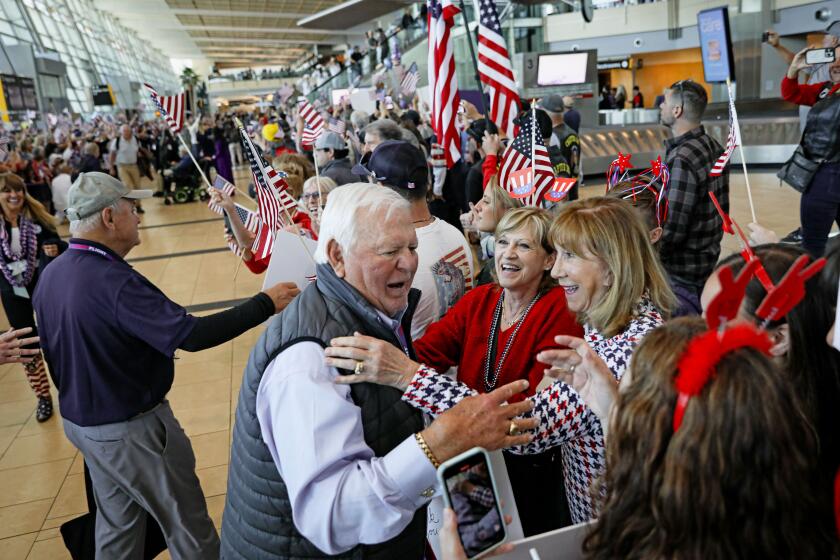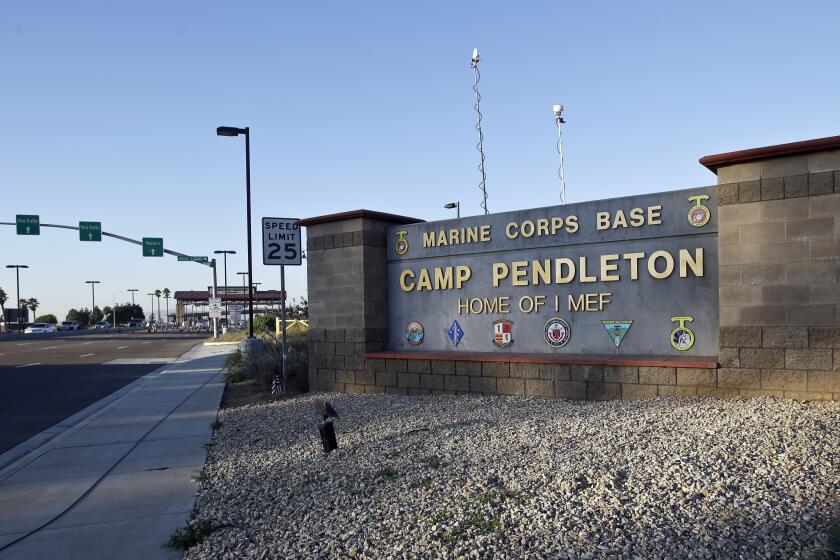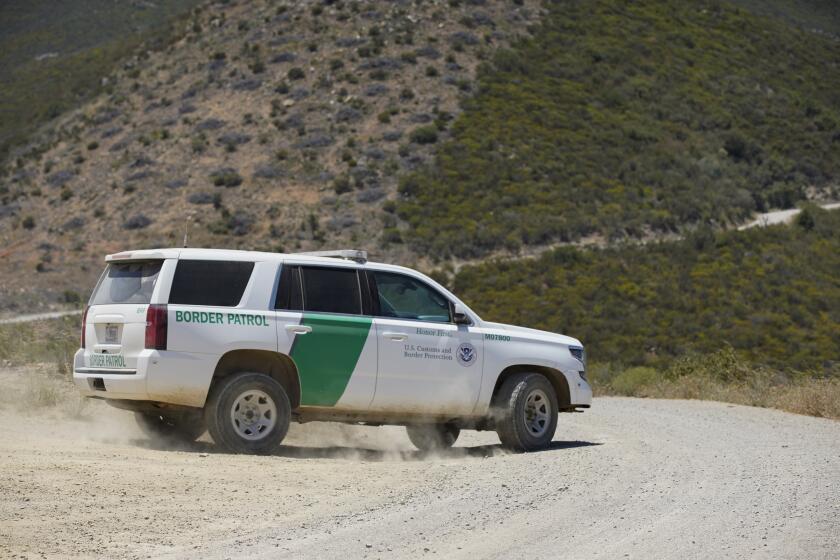Deep ties connect Filipinos, Navy and San Diego
In 1903, a lusty seminarian named Potenciano Parel abandoned his theological studies, assumed a new name and changed the history of the U.S. Navy and San Diego.
“He was the first Filipino to join the United States Navy,” said the man’s 75-year-old son, Andrew Dolopo of Chula Vista. “He liked being called an American.”
With eight other enlistees, Parel — under the assumed name “Tomas Dolopo” — inaugurated a historic experiment. Taking advantage of President William McKinley’s 1901 executive order, these Filipinos became American sailors.
This program would continue for more than 90 years, and play a key role in establishing San Diego’s Filipino-American community. While this relationship was never perfect, both sides reaped benefits. The American fleet enjoyed a fresh source of recruits in an era of expanding responsibilities in the western Pacific, while many young Filipinos saw a sailor’s uniform as a ticket to a better life.
“When you were admitted to the Navy,” said Rommel Alberto, vice president of Balboa Park’s House of the Philippines and a 30-year Navy veteran who enlisted in 1973, “it was like hitting the jackpot for life.”
Despite discriminatory policies and racist attitudes, this allure was strong and brought tens of thousands of newcomers to San Diego County. Filipinos now comprise the region’s largest Asian-American population, and scholars estimate that at least half of these 148,000 residents came here thanks to the Navy.
This history is sometimes painful, often upbeat. For the first family of the Filipino-American Navy, the Dolopos, it’s all personal.
“I joined the Navy in 1964, in Cavite, at the U.S. naval base there,” Andrew Dolopo said. “My dad joined the Navy in the same place.”
Quirks of history
Parel was studying to become a priest when he was seduced by a pair of legs. For months, while kneeling in prayer near a cracked wall inside a Manila seminary, he had enjoyed random glimpses of a woman walking past.
Yielding to temptation, he finally sneaked out of the seminary to chase this vision. Although he searched the city streets for days, he never found the woman. Instead, he found another love, riding at anchor in Manila Bay: the warships of the U.S. Navy.
Fearing he would face punishment back at the seminary, Parel decided to sail away. Unfortunately, he lacked the identification papers the Navy would require.
When a friend offered him his documents, Potenciano Parel seized the opportunity to begin a new life under a new name.
On Aug. 9, 1903, “Tomas Dolopo” became a coal-passer in the U.S. Navy. Enlistment forms describe the recruit as a native of Iloilo, on the island of Panay. He was 23, 4-foot-11, 120 pounds with smallpox scars on his face. His monthly base pay: $34.96.
Dolopo’s enlistment was made possible by several quirks of history. The U.S. victory in the Spanish-American War meant that the Philippines, a former Spanish colony, had become an American protectorate. The U.S. Navy’s Asiatic Squadron also inherited Spain’s naval bases and, once McKinley’s executive order took hold, a new source of sailors and laborers.
An archipelago with more than 7,000 islands, the Philippines has strong maritime roots. Filipino sailors reached Central California’s Morro Bay in 1587, while Filipino fishermen established a village in Louisiana before the American Revolution. In 1919, the Philippines’ legislature honored that tradition by donating a destroyer, the Rizal, to the U.S. Navy,
Filipino applicants to the Navy faced tough entrance examinations and tight quotas, from 500 to 2,000 a year. When Dolopo’s active-duty career ended in 1926, there were only about 4,000 Filipinos in the Navy.
Dolopo joined the reserves, officially retiring in 1936 as a machinist’s mate first class. World War II came suddenly to the Philippines — Japanese forces landed 10 hours after Pearl Harbor was bombed — and numerous Filipinos were imprisoned, including Dolopo. The veteran escaped and spent the rest of the war with guerrilla forces, battling the invaders.
His son Andrew, born in 1940, has dim memories of the war and vivid recollections of his father’s postwar status. On the naval base at Cavite, the elder Dolopo was a legend.
“We would go to the office of the admiral, where you needed an appointment — but he didn’t,” said Andrew Dolopo. “He would go in and get a cup of coffee and chitchat with the admiral. They would allow that!”
Still, none of Tomas Dolopo’s numerous offspring — he would outlive three wives, who gave him 12 children — seemed inclined to follow his career path. None, that is, until one visited a recruiter in March 1964.
Andrew meant to surprise his father with the news of his enlistment. First, though, he celebrated with numerous drinks and one brawl. When Andrew was jailed, his father was willing to let the law take its course.
Andrew’s sister objected. “You’re going to let him rot in jail,” she asked their father, “when he is leaving you?”
“What’s he doing?” Tomas asked.
“Joining the Navy!”
The father went to the police station, and the son was released. After a brief reunion, Andrew Dolopo left for boot camp in the faraway, exotic city of San Diego.
‘Floating Plantation’
New to Andrew Dolopo, San Diego was already well-known to many of his countrymen. In 1903, would-be teachers from the Philippines studied at the Normal School, the predecessor to San Diego State University. And as early as 1908, Filipino sailors had been stationed here.
In the 1920s, they were followed by a band of civilian Filipino reformers. “They were intent on learning U.S. history and government,” said Felix Tuyay, who teaches Filipino-American history at Southwestern College, “and then going back to the Philippines.”
Poverty at home inspired a generation of Filipino farmworkers to head to Hawaii in the 1930s and ’40s, with some moving from the pineapple fields for jobs in California agriculture.
World War II disrupted this flow of labor and severed ties between Washington and Manila. In the wake of Japan’s defeat, the U.S. moved to grant the Philippines its independence, a process that culminated on July 4, 1946.
Despite its independent status, though, the Philippines remained dependent on the United States, and vice versa. Alarmed by the rise of the Communist Party in China and elsewhere in Asia, Washington hammered out a military base agreement with Manila in 1947. Once again, Philippine nationals would be recruited into the U.S. Navy. Only the best were accepted — applicants had to be between 18 and 25, and pass physical and mental exams — although they were not destined for the best jobs.
They were destined to become stewards.
“They were like servants for the senior officers,” said Alberto, who enlisted a year before the Navy discontinued the steward rating in 1974. “They did everything for them, cooked for them, cleaned their quarters, did their laundry, shined their shoes and just about everything else.”
The Washington Monthly dubbed this “The Navy’s Floating Plantation.” Many found the work demeaning.
“They basically taught us the job of the waitress,” Oceanside’s Leo Sicat said in “Beyond the Mask,” Riz A. Oades’ 2005 history of Filipinos in the Navy. “Personally, I was so insulted. I was almost a chemical engineer and I came to the United States just to become a steward.”
Others argued that this job, despite its low status, had some attractions.
“I figured I would not get hungry,” Andrew Dolopo said, “because the food was there.”
Moreover, by the Philippines’ standards the pay was excellent. A year after enlisting, Dolopo married and started a family. Aurora Dolopo, his bride, was able to afford a large house in the Philippines. Yet her husband’s assignments kept taking him to San Diego.
The couple spent most of their first six years of marriage apart. “You are wasting the best years of my life,” Aurora wrote to Andrew. “Take me with you.”
He did. In San Diego, though, a sailor’s salary didn’t go as far. Andrew moved his wife and two daughters into a rented studio apartment in a poor part of Logan Heights.
“We were starting over,” Aurora said. “It was tough.”
Slowly, life improved. They left the apartment for a rented house; then Navy housing; then a home they bought in Paradise Hills.
Andrew acquired something else, too: U.S. citizenship. Filipino veterans of conflicts, from World War I through Vietnam, were granted a swift and relatively easy path through the naturalization process.
“I passed with flying colors,” Andrew said.
He hoped his all-American status would defuse racist comments. “I didn’t want to hear, ‘Go back where you belong,’” he said. “I was serving my country.”
In the 1960s and ’70s, though, it was not uncommon for Filipino sailors to be called “Flip” or other racist slurs. And opportunities were limited. In 1976, of the 17,000-plus Filipinos in the Navy, fewer than 100 were officers. None ranked higher than commander.
“Back in those days,” Andrew Dolopo said, “there was a lot of prejudice.”
While racist cracks were disturbing, Rommel Alfonso found the unspoken messages just as bad: “You were sometimes treated as if you were not an equal. I had to make myself believe that I was just as good.”
Barriers to good jobs and training were especially high for sailors who had not yet become American citizens. Jay Ruiz Sr., who enlisted in Cavite in 1960, remembers serving aboard a Point Loma-based diesel submarine in Point Loma. One day, his crew was scheduled to visit a nuclear-powered submarine. The entire crew took part, except for the group’s one foreign national.
“I was given the day off,” Ruiz said.
Ruiz, who became a U.S. citizen four years after that unwanted holiday, served in the Navy for 20 years. Now 72, he’s secretary for San Diego’s Filipino American Military Officers Association despite the fact that he never attained an officer’s rank.
He owes his office to his association with a retired U.S. Army colonel, his wife, Dr. Ceferina Ruiz. Their family is a blend of Army and Navy, officer and enlisted. Their son, Jay Ruiz Jr., followed in his mother’s footsteps, serving in the Army as an operating room technician.
“It doesn’t matter what job you do, you are all contributing,” Ruiz Sr. said. “I strongly feel we Filipinos have contributed a lot.”
Tradition continues
San Diego County’s Filipino population grew dramatically during Ferdinand Marcos’ two decades as the Philippines’ president. The former World War II guerrilla fighter was elected in 1965 when the poor country was suffering from a brain drain.
“These were professionals — doctors, lawyers and nurses,” Southwestern’s Tuyay said.
After Marcos declared martial law in 1972, these immigrants were joined by college students and political protesters like Rommel Alfonso. Targeted by the Marcos regime, many fled the country.
“For them,” Tuyay said, “the U.S. Navy meant security and safety. They were political refugees.”
San Diego, where most recruits underwent basic training, beckoned with its warm climate. Many were stationed here and, after their naval careers were over, found jobs in local shipyards, agriculture and civil service. Andrew and Aurora Dolopo’s early dreams of retiring to the Philippines faded away, as their children and grandchildren built lives in the United States.
“After living here so many years,” Andrew Dolopo said, “something grows inside of you. You are American.”
On an official level, at least, links between Manila and Washington weakened. The U.S. shut down its bases in the Philippines toward the end of 1992, and the Navy stopped recruiting Filipino nationals. While the statistics are incomplete, the Pentagon reported that 34,620 Filipinos had enlisted between 1952 and 1990.
Yet the service’s ties to the Filipino-American community remain strong, as new generations followed their parents to sea. A familiar story, but with some positive new twists.
Consider the experience of Ed Buclatin, who grew up in Mira Mesa as the son of Stanley Buclatin, a retired steward first class. Influenced by his father’s sea stories, and entranced by the sight of jets flying out of nearby Miramar Naval Air Station, Ed enlisted in the Navy in 1984.
His career followed a trajectory that his father could have only imagined. He flew E-2C Hawkeyes for eight years and traveled the world. In 2010, he retired as a captain.
Asked if he ever experienced discrimination in the Navy, the younger Buclatin’s answer is concise and unqualified: “No.”
Any restrictions on the sorts of jobs he or other Filipinos could pursue within the service?
“Not at all.”
Part of this was because he was Filipino by heritage, American by birth. “Since my father was not a U.S. citizen when he joined the Navy in the early ’50s,” Buclatin noted, “he was not able to obtain a security clearance, which limited the ratings he could serve in.”
Part of it, though, was due to a sea change in attitudes. Overt racism of the sort Rommel Alfonso had routinely encountered is no longer tolerated.
“Since I retired,” Alfonso said, “the Navy has become a lot more professional. For instance, you can’t say ‘Flip’ any more.”
In 2014, Capt. Ronald Ravelo took command of the aircraft carrier Abraham Lincoln, becoming the first Filipino-American to take a carrier’s helm. There are Filipino-American admirals, too, including a woman — Rear Adm. Babette “Betty” Bolivar.
Andrew Dolopo never reached such heights, at least not in uniform. He retired in 1983, honorably discharged as a chief petty officer, for family reasons. His 16-year-old daughter, Analyn, was pregnant and single. Wanting to help raise his grandchild, Andrew left the service and sought a job close to home.
He found work as a hospital custodian.
“He was the happiest janitor ever,” Analyn Dolopo said. “We are really indebted to him.”
Analyn resumed her studies, becoming a nurse. She considered enlisting in the Navy, like her dad. But, again like her dad, she decided to focus on raising her daughter, Angela.
Yet the family tradition continues in the person of Petty Officer 1st Class Brett Flores — Angela’s husband and thus Tomas Dolopo’s great-grandson by marriage. An American of Guamanian and Filipino heritage, Flores finds Andrew Dolopo’s tales of life in the service strangely familiar — and his stories of discrimination strange.
“Now you find anybody anywhere doing everything,” Flores said. “It’s a very diverse Navy now.”
Get Essential San Diego, weekday mornings
Get top headlines from the Union-Tribune in your inbox weekday mornings, including top news, local, sports, business, entertainment and opinion.
You may occasionally receive promotional content from the San Diego Union-Tribune.

